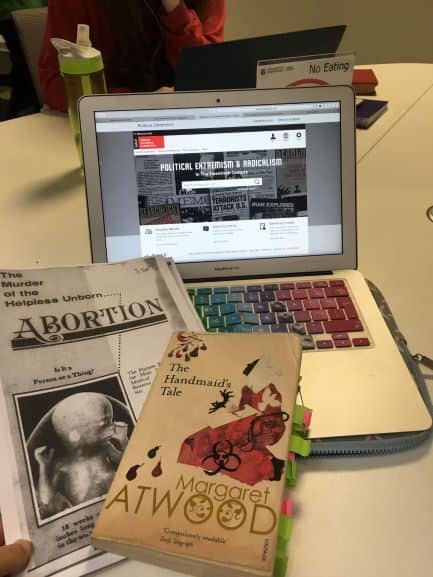By Lily Cratchley, Gale Ambassador at the University of Birmingham
Are you a budding politician or historian, intrigued with all things politically radical and extreme? Or perhaps you’re just faced with the need to write a lengthy dissertation, and are worried by your seemingly limited quantity of primary sources? Either way, Gale’s new archive, Political Extremism and Radicalism in the Twentieth Century, may be of extreme (pardon the pun!) interest to you.
The archive offers students a unique and exciting perspective on history. It compiles periodicals, campaign propaganda, government records, and even oral histories from various extremist groups. Whether your academic interests lie in researching the struggle to secure rights for women, homosexuals, African-Americans or Jewish people, this archive can support your studies, providing an abundance of material in all these areas.
An intriguing aspect of the archive is the behind-the-scenes view a student can gain into the campaign strategies of several extremist groups, including Communists, Nazis, Socialists, and many more. When browsing a collection of Fascist Leaflets and Stickers, I was astonished by various Far-Right campaign stickers, including the two pictured below.

Political groups in Great Britain, such as the British National Party and Britain First, and more globally, including the National Socialist Party of Australia, are some of the organisations behind this sort of extremist propaganda. While the primary sources in this archive are hard-hitting and controversial, they provide historians with a realistic, uncensored depiction of the political activism that existed in the twentieth century, and a greater understanding of global politics.
This archive is in no way exclusive to History or Politics students; everyone at the University of Birmingham is able to examine these sources. Being an English Literature student myself, I found this archive incredibly relevant when writing an essay on Margaret Atwood’s The Handmaid’s Tale for a module which looks specifically at dystopian texts.

Dystopian fiction critiques extremist trends in present-day life, and raises awareness of their potential growth and consequences. The Handmaid’s Tale depicts a society, ‘Gilead’, in which some women have the sole purpose to bear children and have all their freedom and reproductive rights taken away. The parallels I uncovered between anti-abortionist propaganda from extremist ‘Right to Life’ groups in the archive and certain parts of The Handmaid’s Tale were eye-opening.
It was clear when reading a ‘National Right-to-Life Committee’ pamphlet where Atwood’s inspiration may have derived from. The pamphlet, pictured below, criticises the legalisation of abortion and promotes the views of the ‘Right-to-Life’ movement. In the pamphlet, the movement dismisses the argument that abortion should be legalised for rape victims, declaring that ‘pregnancy from rape is extremely rare,’ and suggests a mother does not have the right to her own body as ‘This is not her body but the body of another human person.’

Interestingly, Atwood envisions a future in which these extremist views become reality. The Handmaid’s Tale presents a society in which ‘No woman in her right mind, these days, would seek to prevent a birth, should she be so lucky to conceive,’[1] echoing the mind set of this extremist group. The issue of abortion and rape is also raised by Atwood through the character of Janine: ‘It’s Janine, telling about how she was gang-raped at fourteen and had an abortion. But whose fault was it? Aunt Helena says, holding up one plump finger. Her fault, her fault, her fault, we chant in unison.’[2] Here, Janine’s abortion is not justified as the conception is not seen as rape, but rather invoked by Janine herself, mirroring the National Right-To-Life’s dismissive take on this issue.
Political Extremism and Radicalism also includes many visual sources which illustrate the views of these extreme anti-abortion groups through stickers and literature, as pictured below.

Right Right to Life of Greater Lansing, Michigan. June, 1981-1989. MS The American Radicalism Collection: Part 2: The Religious and Radical Right. Michigan State University. Political Extremism & Radicalism http://tinyurl.galegroup.com/tinyurl/8ygnD4 (p.9)
More harrowing for me were the elements of anti-abortionist violence depicted in Atwood’s fictional novel that some of these primary sources suggest may be turning into a reality. An edition of Searchlight Magazine in 2000, states, of Dr Barnett Slepian, ‘he was the sixth abortion doctor to be murdered since 1991,’ while another edition of Searchlight, published in 1999, focuses on the death of ‘Dr David Gunn’ due to ‘some anti-abortion activists turning to terrorism and murder.’

Right Offley, Will. “Anti-Abortion Violence.” Searchlight Magazine, May 1999, p. 13. Political Extremism & Radicalism, http://tinyurl.galegroup.com/tinyurl/8to4i1
Atwood’s 1985 novel spookily predicts what these sources reveal, as she foresees a dystopian future in which the government is allowed to kill abortion doctors, ‘There are six more bodies hanging, by the necks, their hands tied in front of them…Each has a placard around his neck to show why he has been executed: a drawing of a human foetus. They were doctors then, in the time before, when such things were legal.’[3]
My studies into the comparisons between dystopian fiction and extreme political views exhibited in the twentieth century were undeniably aided by the source material attained from Gale’s Political Extremism and Radicalism in the Twentieth Century archive. My essay focused on a very specific topic within literature, yet this archive enabled me to find more than enough relevant sources to discuss.
Are you a student at the University of Birmingham? If so, click here to explore the archive! Your university is currently trialling this database. It may only be available in February – so make the most of these great primary sources asap!
[1] Margaret Atwood, The Handmaid’s Tale, Vintage Books, 1996
[2] Ibid.
[3] Ibid.

